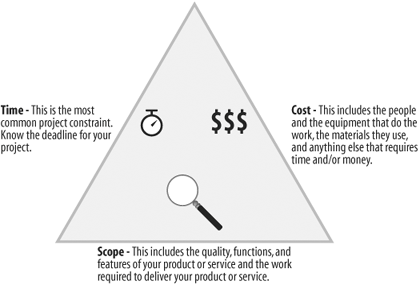Lesson 1.2. Understanding Project Management Figure 1-2. The Project Triangle 
We all basically know what a project is, but here is a clear definition: A project is a temporary series of actions undertaken to create a unique product or service. A project can be anything from building a fleet of helicopters, to planning a wedding, to writing a sushi cookbook. All projects have three things in common: (1) they have a start and end date, (2) they are an effort made by people and equipment, and (3) they create a product or service. You've probably already completed many projects and are working on many projects as we speak. That means you already have experience with project management. Project management is the process of planning, organizing, and managing tasks and resources to accomplish an objective, usually within constraints of time, resources, or cost. Project management has been a recognized profession since the 1950s but has been practiced since the Stone Ages. Without project management, we would still be wearing animal hides and rubbing sticks together to make fire. An easy way to visualize the elements of project management is by using the Project Triangle, as shown in Figure 1-2. The Project Triangle views project management in terms of time, cost, and scope. Time is the amount of time it will take you to complete your project. Cost is the amount of money and time you will spend on the project. Scope is the quality, functions, and features of your product or service.
Tip: Adjusting one of the Project Triangle elements affects the other two.
To see what happens to project management when one side of the Project Triangle changes, see Table 1-2. Table 1-2. If/Then in the Project TriangleIf | Then |
|---|
If the project scope increases... | ...then you may need more resources and/or additional time to do the extra work. | Example: If you decide you want to publish a definitive textbook instead of your original plana brief reference paperback... | ...then either you find graduate students to help research the book, or you postpone the release of the book to allow time for the extra research. | If the time (duration) of your project schedule decreases... | ...then you may need to increase cost (budget) in order to hire more resources to get everything done on time. If you can't increase the cost, you may need to reduce the scope, because it will be hard to get things done in less time. | Example: If you need to move your release date up two months in time for the new academic year... | ...then either you recruit additional writers to contribute to the book, or you decide not to publish the book in hardcover. | If the cost (budget) of your project decreases... | ...then you may need more time because you can't pay for as many resources. If you can't increase the time, you may need to reduce the scope, because fewer resources can't finish all of your planned work in the time you have scheduled. | Example: If the cost of one of the contributing authors puts you over your budget... | ...then extend the deadline so another author can write the chapter, or leave out that chapter of the book. |
The key to product management is keeping careful records and tracking your project. Microsoft Project 2003 will do that for you, so you can foresee any problems before they arise and adjust to changes accordingly. QUICK REFERENCE ALL PROJECTS: HAVE A START AND END DATE ARE EFFORTS MADE BY PEOPLE OR EQUIPMENT CREATE A PRODUCT OR SERVICE
THE PROJECT TRIANGLE INCLUDES: 
|
|

